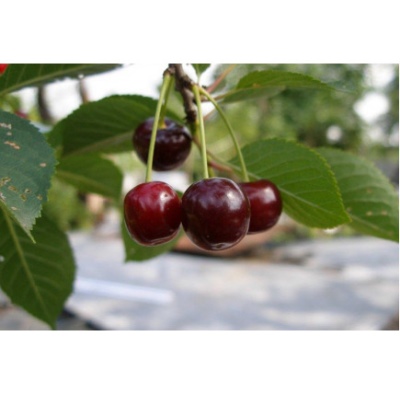
- Authors: H.K. Enikeev, S.N. Satarova, A.I. Evstratov (All-Russian Institute of Selection and Technology of Horticulture and Nursery)
- Year of approval: 2001
- Barrel type: wood
- Growth type: medium-sized
- Crown: spherical, spreading, medium density
- Leaves: oval-elongated, dark green, matte, with a smooth edge
- Flowers: medium
- Flowering and fruiting type: on the growths of last year and bouquet twigs
- Fruit size: average
- Fruit shape: one-dimensional, rounded
At first glance, the common cherry of the Brunetka variety attracts attention with its rich dark color of ripe berries. A compact fruit tree can be easily placed even in a small area. The average early maturity allows the first harvests to begin only 6 years after planting.
Breeding history
The variety was obtained by specialists of the All-Russian Institute of Selection and Technology for Horticulture and Nursery by free pollination of Zhukovskaya cherry. He entered the variety trials in 1995, but received approval for use only in 2001.
Description of the variety
Cherry trees of the Brunetka variety are medium-sized, 2-2.5 m high. The crown of the correct spherical shape is prone to spreading, medium thickened. Fruiting occurs on the growths of the last year and bouquet twigs. The flowers are medium in size, collected in inflorescences that resemble umbrellas. Dark green leaves with matte plates and smooth edges have an oval-elongated shape.
Fruit characteristics
The cherries are medium in size, each weighing about 3.7 g. The shape of the fruit is round, they are one-dimensional, colored inside and outside in a dark red color. The stone is small, well separated from the pulp. Thin skin is easily wrinkled, does not provide long-term storage, after harvesting the fruits lie for about 6-7 days. The berries are firmly attached to the stalks, do not crumble.
Taste qualities
Juicy, pleasantly delicate fruits have a delicious sweet and sour taste. Their tasting score is high, reaching 4.4 points fresh. The brightly colored juice is very tasty both fresh and canned, and from the fruits of the Bruneta delicious preserves, jams, syrups are obtained.
Ripening and fruiting
The brunette belongs to the medium-ripening cherry varieties. It bears fruit on July 20-25.

Yield
The brunette has a high yield. On average, 10-12 kg of fruits are harvested from a tree, up to 8-10 tons per hectare.
Growing regions
According to the State Register, this cherry is zoned for cultivation in the Central Region.
Self-fertility and the need for pollinators
The tree begins to bloom in May. Since the Brunette is classified as a self-fertile variety, it is not necessary to have pollinating trees nearby, but they can increase yields and contribute to an increase in the size of the fruits. For these purposes, Vladimirskaya cherries, in memory of Yenikeev, are suitable.
Landing
In the south, plants are transferred to a new location closer to mid-autumn. In the middle lane, the best period for this is considered to be the 2nd decade of September.Spring planting is preferred when grown in colder climates. In choosing a location, preference is given to the hills. Steep slopes, bathed in sun for most of the day, will come up.


Growing and care
Watering rates for Brunetta cherries are about 3 liters per tree. A month before harvesting, the introduction of moisture is completely stopped. Fertilizers are applied periodically, giving preference to complexes containing nitrogen, potassium and phosphorus. The first feeding is performed after 2-3 years from the moment of planting, performing it at the end of the flowering of the cherry tree, and then after another 2 weeks.
To maintain a neat, compact crown shape, the plant needs pruning. All branches located above the soil level at a height of up to 50 cm are removed. Dry shoots without growths are also cut out, directed towards the inside of the crown.


Disease and pest resistance
According to the degree of resistance to fungal diseases, the variety is rated average. It is resistant to coccomycosis. Moderately affected by moniliosis. Anthracnose should be wary of during the fruiting period in a damp summer. On the leaves under unfavorable climatic conditions, perforated spotting develops. Periodic spraying with copper-containing preparations will be required.
Requirements for soil and climatic conditions
The winter hardiness of the variety is estimated to be above average. With a strong drop in atmospheric temperatures in spring, flower buds can be affected by frosts, which significantly affects the yield. Plants tolerate drought well; it will be necessary to increase the rate of watering in the heat only during flowering and the formation of ovaries, as well as during leaf fall. The soil should have neutral acidity, air permeability. Drained woody-podzolic soil or loam is suitable, in the south - black soil.

Review overview
Summer residents are eager to get hold of this rare cherry variety. The brunette is the real pride of any collection, and her fruits are considered one of the most delicious. Especially a lot of positive reviews are associated with regular and abundant harvests. The cherry tree in summer is literally strewn with fruits, and they are really large and sweet, ripen easily on the branches.
There are practically no negative reviews about the Brunette. For 10 years, many summer residents have not had any difficulties with infection by fungi and infections.The only small drawback is the low keeping quality of the berries; they can be preserved only when frozen.































































